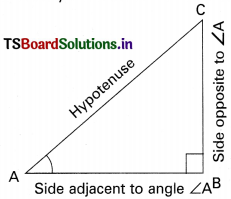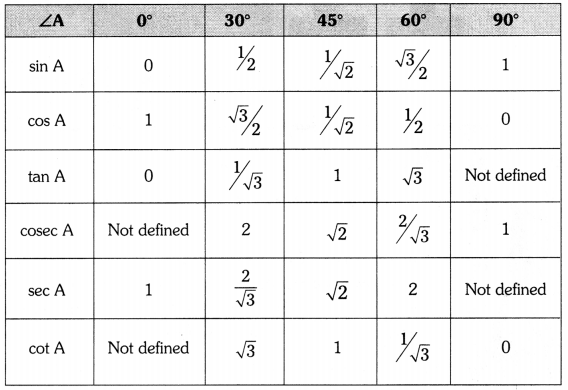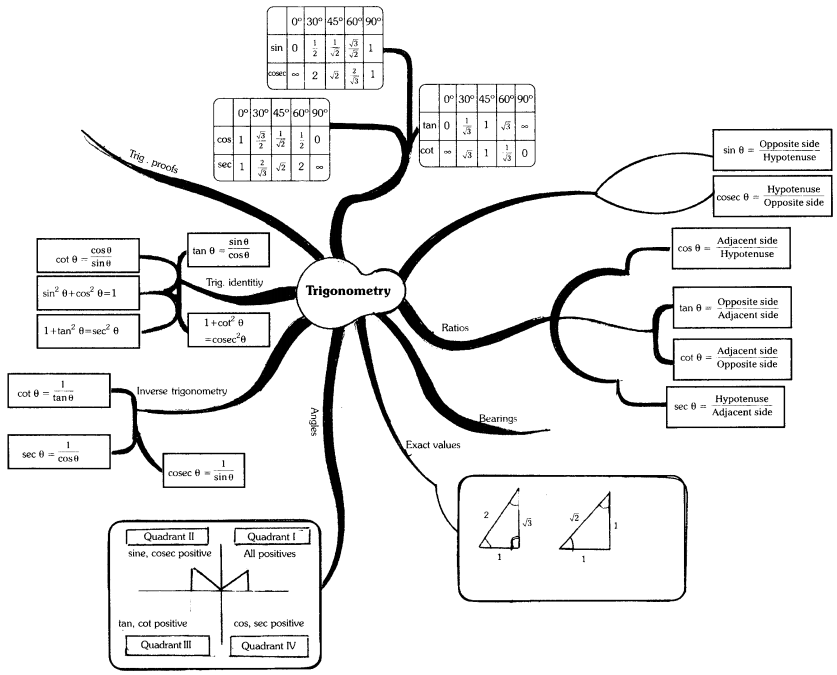We are offering TS 10th Class Maths Notes Chapter 11 Trigonometry to learn maths more effectively.
TS 10th Class Maths Notes Chapter 11 Trigonometry
→ Trigonometry is the study of relationship between the sides and angle of a triangle.
→ Ratios of the sides of a right triangle with respect to its acute angle are called trigonometric ratios of the angle.
→ An equation involving trigonometric ratios of an angle is called a trigonometric identity. If it is true of all values of the angle.
→ Let us consider ΔABC in which ∠B = 90°, A and C are acute angles. Let us study the ratios of the sides of ΔABC with respect to the acute angle A.

sine of ∠A = sin A = \(\frac{\text { Side opposite to angle } \mathrm{A}}{\text { Hypotenuse }}=\frac{\mathrm{BC}}{\mathrm{AC}}\)
cosine of ∠A = cos A = \(\frac{\text { Side adjacent to angle } \mathrm{A}}{\text { Hypotenuse }}=\frac{\mathrm{AB}}{\mathrm{AC}}\)
tangent of ∠A =tan A = \(\frac{\text { Side opposite to angle } A}{\text { Side adjacent to angle } A}=\frac{B C}{A B}\)
→ cosec A = \(\frac{1}{\sin A}\)
sec A = \(\frac{1}{\cos A}\)
cot A = \(\frac{1}{\tan A}\)
![]()
→ If one of trigonometric ratios of an acute angle is known the remaining trigonometric ratios of the angle can be easily determined.
→ Trigonometric ratios of 0°, 30°, 45°, 60° and 90°.

Note : From the above table we can observe that ∠A increases from 0° to 90°, sin A increases from 0 to 1 and cos A decreases from 1 to 0.
→ Trigonometric ratios of complementary angles : Two angles are said to be complementary angle if their sum equals to 90°.
- sin (90° – A) = cos A;
- cosec(90° – A) = sec A
- cos (90° – A) = sin A;
- sec(90°- A) = cosec A
- tan (90° – A) = cot A;
- cot(90° – A) = tan A
→ Trigonometric identities :
- sin2A + cos2A = 1
- sec2A – tan2A = 1 for 0°< A < 90°
- cosec2A – cot2A = 1 for 0° < A < 90°
Note : sin2θ = (sin θ)2 but sinθ2 ≠ (sin θ)2
Important Formula:
- sin(90° – A) = cos A;
- cosec (90° – A) = sec A
- cos(90° – A) = sin A
- sec(90° – A) = cosec A
- tan(90° – A) = cot A
- cot(90° – A) = tan A
- sin2A + cos2A = 1
- sec2A – tan2A = 1
- cosec2A – cot2A = 1
Flow Chat:

![]()
Aryabhatta (476 – 550 A.D):
- The first use of the idea of ‘sine’ in the way we use it today was in the book Aryabhatiyam by Aryabhatta, in A.D. 500.
- Aryabhatta used the word ‘ardhajya1 for the half-chord, which was shortened to jya or jiva in due course.
- When the Aryabhatiyam was translated into Arabic, the word jiva was retained as it is. The word jiva was translated into sinus, which means curve, when the Arabic version was translated into Latin.
- Soon the word sinus, also used as sine, became common in mathematical texts throughout Europe. An English Professor of astronomy Edumund Gunter (1581¬1626), first used the abbreviated notation ‘sin’.